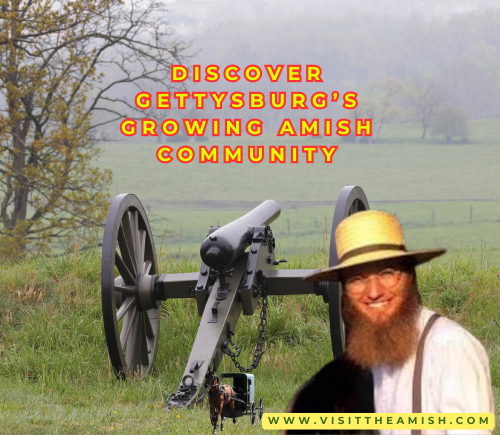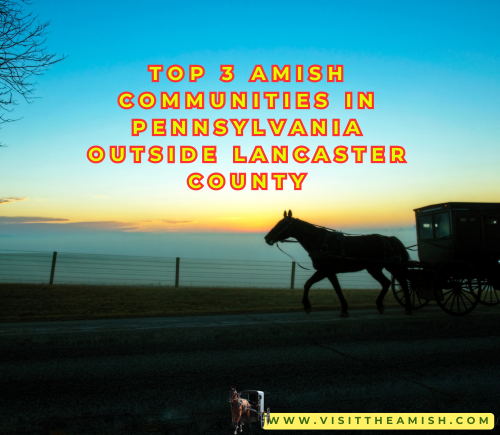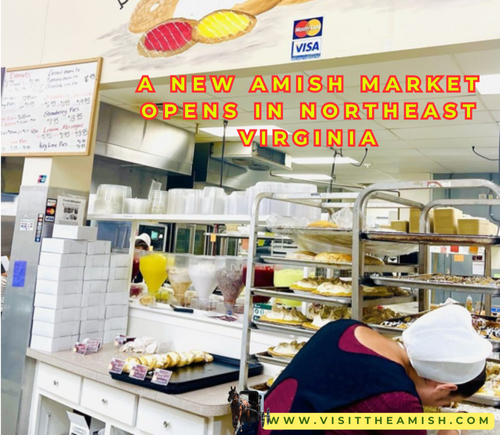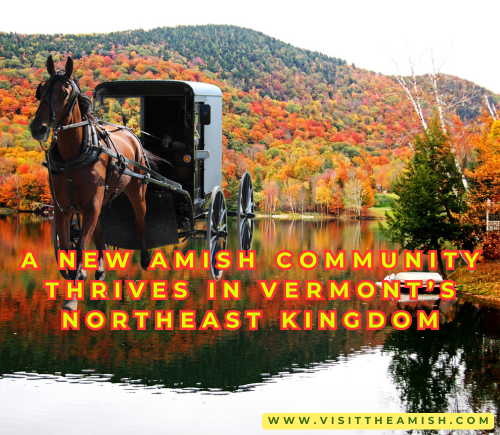A New Amish Community Blossoms in Gettysburg, PA
Gettysburg, Pennsylvania, famous for its Civil War history and picturesque countryside, now has another reason to attract visitors: a growing Amish community. Located just south of downtown Gettysburg in Adams County, this new settlement is quickly becoming a hub for sustainable farming, handmade goods, and cultural exchange. With over 75 families now calling the area home, the community is creating opportunities for locals and tourists alike to experience authentic Amish traditions.
The Story of Gettysburg’s Amish Settlement
The Amish began settling in the Gettysburg area in 2022, with families relocating from Lancaster County in search of affordable farmland and a quieter pace of life. Today, the community has flourished into a network of small farms and businesses that prioritize sustainable practices and traditional values.
Jacob King, owner of King’s Farmstead and Market, shared his thoughts on the move: “When we came here, there were only 14 families. Now we’re 75 strong. Gettysburg has been welcoming, and we’re grateful to share our way of life with the people here.”

Local Businesses Supporting Amish Traditions
At the heart of the community is King’s Farmstead and Market, located just 15 minutes south of downtown Gettysburg. This market has become a favorite destination for locals and tourists alike, offering organic produce, pasture-raised meats, raw milk, fresh baked goods, local honey, and canned goods. On Saturdays from April to October, visitors can enjoy chicken and pork BBQ while strolling through the flower market or stocking up on farm-fresh items.
Sarah Brubaker of Brubaker Apiaries explained: “Our honey is made by bees that thrive here in Adams County. We’re proud to be part of this community effort to offer clean, natural food.”
Other businesses like Mountain View Farms Dairy and Glicks Homestyle Canning contribute to the market’s offerings, creating a network of high-quality goods produced by local families.
Voices from Locals and Tourists
Residents have embraced their new neighbors wholeheartedly. Jane Miller from Gettysburg shared: “The Amish have brought something special to our town. Their farming practices are inspiring, and their markets are a joy to visit.”
Tourists are equally impressed by the community’s authenticity. Emily Carter from Baltimore remarked: “I’ve visited Lancaster before but coming to Gettysburg feels different—it’s quieter and less commercialized. The Amish market here is incredible.”
What Tourists Can Do in Gettysburg’s Amish Community
Visitors looking to explore Gettysburg’s Amish settlement will find plenty of activities that highlight the community’s traditions:
- Shop at King’s Farmstead and Market: Pick up fresh produce, baked goods, or handmade crafts while enjoying the scenic farm views.
- Attend Seasonal Events: From BBQ Saturdays to harvest festivals in the fall, there are plenty of opportunities to experience Amish culture firsthand.
- Take Scenic Drives: The countryside surrounding Gettysburg offers beautiful views of farmland dotted with horse-drawn buggies.
- Learn About Sustainable Farming: Many farms welcome visitors who want to learn more about organic practices or purchase directly from growers.

Challenges Faced by the Community
While the Amish settlement has thrived in Gettysburg, it hasn’t been without challenges. Navigating Pennsylvania’s building codes has required adjustments to traditional construction methods for homes and barns. Additionally, horse-drawn buggies sharing roads with modern vehicles have raised safety concerns.
Jacob King explained: “We’ve worked closely with local officials to address these issues while staying true to our beliefs. It’s been a learning process.”
Despite these obstacles, both locals and Amish families remain optimistic about their future in Adams County.
A Unique Blend of History and Tradition
Gettysburg is already known as a destination for history buffs eager to explore Civil War battlefields and museums. Now, its growing Amish community adds another layer of cultural richness to the area.
Mark Johnson from Destination Gettysburg remarked: “The addition of the Amish community has been wonderful for tourism—it gives visitors another reason to come here and experience something truly unique.”
Looking Ahead
As more families join Gettysburg’s Amish settlement, plans are underway to expand local markets and introduce additional events like holiday craft fairs and produce auctions. The community hopes to continue fostering connections with locals while sharing their values through food, craftsmanship, and sustainable farming.
Jane Miller summed it up best: “The Amish have brought something timeless to Gettysburg—a reminder that simplicity can be beautiful.”
For now, visitors can enjoy a taste of this tradition by stopping by King’s Farmstead or exploring the scenic backroads that make Adams County so special.

Citations:
[1] https://www.discoverlancaster.com/amish/
[2] https://www.spokesman.com/stories/1995/may/21/in-and-around-gettysburg-from-amish-settlements/
[3] https://www.cbsnews.com/pittsburgh/news/amish-community-robbery-mercer-county/
[4] https://kingsfarmsteadandmarket.com
[5] https://amishamerica.com
[6] https://kingsfarmsteadandmarket.com/our-farm-and-market
[7] https://destinationgettysburg.com/things-to-do/gettysburg-shopping/
[8] https://www.acfarmersmarkets.org
[9] https://www.instagram.com/theamishvillage/
[10] https://www.globetreks.com/pennsylvania-dutch-country-2025
[11] https://www.viator.com/tours/Lancaster/Amish-Experience-Visit-In-Person-Tour/d24305-61054P1
[12] https://www.tripadvisor.com/ShowTopic-g28959-i112-k7209992-Amish_Anywhere_in_PA_besides_Lancaster_County-Pennsylvania.html
[13] https://www.getyourguide.com/amish-experience-l121715/tours-guiados-tc1144/
[14] https://www.yelp.com/search?find_desc=Amish&find_loc=Gettysburg%2C+PA+17325
[15] https://amishcountrynews.com
[16] https://www.pinterest.com/pin/amish-proverb-the-dearest-things-in-life-are-mostly-near-at-hand–138063544803422684/
[17] https://www.youtube.com/watch?v=lWOsZ0w8a0s
[18] https://www.yelp.com/search?find_desc=amish&find_loc=Gettysburg%2C+PA+17325
[19] https://www.instagram.com/mll711/p/C8M7Q_zO8Nl/
[20] https://civilwartalk.com/threads/amish-in-the-civil-war.46666/
[21] https://kingsfarmsteadandmarket.com/store/bread
[22] https://www.mapquest.com/us/pennsylvania/amish-barnyard-277741028
[23] https://www.yelp.com/search?find_desc=Amish&find_loc=Gettysburg%2C+PA
[24] https://www.yelp.com/search?find_desc=Amish+Market&find_loc=Gettysburg%2C+PA
[25] https://www.tripadvisor.com/ShowTopic-g52341-i2815-k5458209-PA_amish_country-Chambersburg_Pennsylvania.html
[26] https://www.tripadvisor.com/ShowTopic-g60798-i335-k12643408-Gettysburg_and_Amish_Country_trip-Gettysburg_Pennsylvania.html
[27] https://www.tripadvisor.com/Attraction_Review-g60798-d15795042-Reviews-Harvest_Barn_Country_Market-Gettysburg_Pennsylvania.html
[28] https://www.tripadvisor.com/AttractionProductReview-g52206-d14019390-Amish_Experience_Visit_In_Person_Tour-Bird_in_Hand_Lancaster_County_Pennsylvania.html
[29] https://www.fodors.com/community/united-states/gettysburg-amish-country-colonial-williamsburg-this-summer-1678192/
[30] https://www.ohiosamishcountry.com/articles/amish-etiquette
[31] https://thesaltandlightjourneys.com/2021/09/29/amish-dutch-country/
[32] https://yahwehssong.wordpress.com/2011/08/04/amish-proverbs/
[33] https://www.reddit.com/r/gis/comments/stxtnz/dataset_of_amish_settlements_in_the_us/
[34] https://www.azquotes.com/quotes/topics/gettysburg.html
[35] https://myitchytravelfeet.com/southern-pennsylvania-road-trip/
[36] https://www.onlyinyourstate.com/experiences/pennsylvania/shady-maple-farm-market-pa
[37] https://padutchmarket.com











